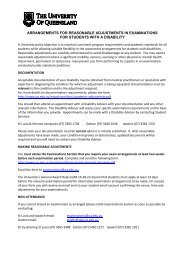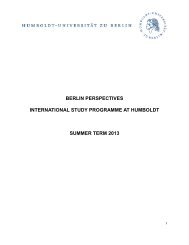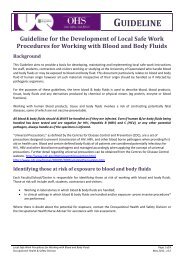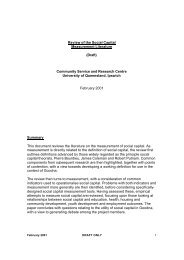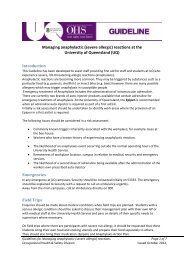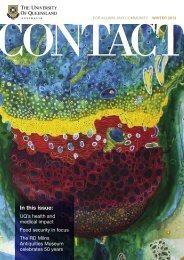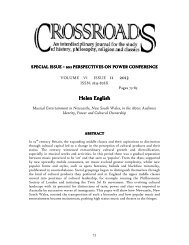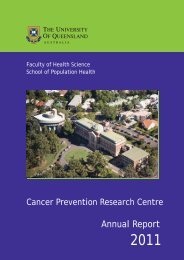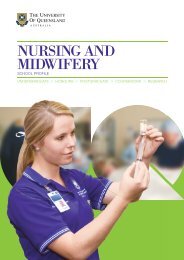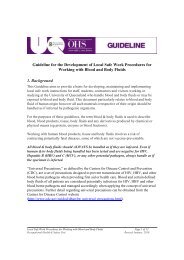Making Abundant Natural Resources Work for Developing Economies
Making Abundant Natural Resources Work for Developing Economies
Making Abundant Natural Resources Work for Developing Economies
You also want an ePaper? Increase the reach of your titles
YUMPU automatically turns print PDFs into web optimized ePapers that Google loves.
1. IntroductionThis study is related to two strands of literature. The first significant line of workconcerns natural resources and economic growth, which typically conjectures thateconomies with low levels of investment tend to be plagued by the natural resourcecurse. The second significant line of work relates to the interaction between financialdevelopment and growth. It has been documented that a well-developed financialsystem is, among other things, able to efficiently allocate resources and thus boostinvestment (McKinnon, 1973; Shaw, 1973).A vast amount of both theoretical and empirical literature has established a positiveimpact of financial development on economic growth. Authors such as Levine (1997)have linked financial development and economic growth through two main channels.The first is by facilitating an increasing savings, there<strong>for</strong>e resources, which can bechanneled towards investment. The second is by improving resource allocation andhence the efficiency of investment. On this basis, finance is potentially one factor thatcould explain the differences in capital accumulation hence economic per<strong>for</strong>mance.However, the effect of financial development on growth, taking into account thepossible dampening effect of natural resource abundance, has not been studiedthoroughly yet. Among the few studies, Nili and Rastad (2007) concluded thatcontrary to the general consensus, financial development had a net dampening effecton investment and growth in oil exporting economies. Furthermore, they observedthat these economies were characterised by weak financial institutions whichcontributed to the poor per<strong>for</strong>mance in terms of economic growth. Based on a sampleof eighty-five countries, faced with differing natural resource intensities, Gylfason
and Zoega (2001) found that high natural resource dependence was associated withlow financial development. The low/weak financial institutions documented by suchstudies clearly has the potential to detract from economic per<strong>for</strong>mance by hinderingcapital accumulation. 3To further explain the role financial development plays in the presence of abundantnatural resources, this paper uses recently developed time series panel unit root,cointegration and causality tests. The paper makes a contribution to both the financegrowthand natural resource-growth literatures in several ways. Firstly, byappreciating the possible detrimental effect of natural resource abundance, it isintended to complement a handful of studies (such as Apergis, Filippidis, &Economidou, 2007; Christopoulos & Tsionas, 2004) that employ similar paneltechniques (and time series) to examine the relationship between financialdevelopment and economic growth. Secondly, with regard to the natural resourcegrowthliterature, it intends to complement (Nili & Rastad, 2007) by examining bothoil and non-oil abundant economies and more importantly in terms of themethodology used. 4The set up here allows us to firstly determine whether there is a structural long runrelationship (without which short run dynamics can be misleading) between financialdevelopment and economic growth. This enables us to confidently determine the shortrun dynamics. The commonly used Generalized Method of Moments (GMM)dynamic estimators are designed to, among other things; deal with the issue ofsimultaneity at the expense of not appreciating the integration and cointegration3 The finding is consistent with the new growth literature (e.g. Romer, 2006) that views capitalaccumulation as a key determinant of differences in output per<strong>for</strong>mances.4 Nili and Rastad (2007) uses the commonly used first difference GMM estimation procedure.
properties of the data. 5 Consequently, one cannot tell whether the estimated panelmodels are representative of a structural long run relationship or a spurious one(Apergis et al., 2007; Christopoulos & Tsionas, 2004). The paper also appreciates thatcorrelation among variables does not imply causation. Gylfason & Zoega (2001)determined that high natural resource dependence was correlated with a low degree offinancial development. Carrying out <strong>for</strong>mal causality tests and taking into accountpossible simultaneity biases sheds additional light on this issue, and among otherthings, the existence or non-existence of the highly debated natural resource curse.2. Literature review<strong>Natural</strong> resources (usually comprising primary commodities) have, in the history ofeconomic thought, been treated as less important than labour and capital. Be<strong>for</strong>e thetwentieth century, they played a pivotal role in world trade with many countries, suchas Australia, US and Canada enjoying the strong support from primary commodityexports in the early stages of their economic development (Auty & Mikesell, 1998;North & Thomas, 1973). In the twentieth century, primary exports were treateddifferently as a result of their failing to deliver satisfactory growth outcomes. Contraryto conventional wisdom, a growing body of evidence indicates that natural resourceabundance may be harmful to development in low and middle income level countries.This counter-intuitive result <strong>for</strong>ms the basis of the resource curse thesis (Sachs &Warner, 2001; Nankani, 1979).There is an established body of empirical literature that shows that mineral economiestend to under-per<strong>for</strong>m relative to their non-mineral counterparts (Auty & Mikesell,5 For example in Nili & Rastad, 2007; Beck, Lundberg, & Majnoni, 2006; Levine, Loayza, & Beck,2000.
1998; Auty, 1993; Gelb & Associates, 1988). One of the commonly cited reasons isthat the contributions of the mineral sector to economic growth take ‘the <strong>for</strong>m of aseries of booms and downswings’ (Auty, 1993). The impact of the mineral sector oneconomic growth is closely linked to the government’s budget through the taxationand royalties generated. 6 The repeated occurrence of revenues that are in excess ofnormal return on capital and production costs often bring about instability in theeconomy. In the absence of measures to ‘smooth out’ volatile revenue inflowsgenerated by natural resources, taxes that accrue to the government are cyclical. Theunpredictability of these cycles tends to create considerable misallocation of resourcesthat impact negatively on the non-mineral tradable sectors. Thus the effectiveness ofusing these large revenues <strong>for</strong> development has been severely hampered by increasesin revenue volatility (Auty, 1993).There are other channels through which natural resource dependence could reduceeconomic growth (e.g. rent seeking, Dutch disease, over optimism of governmentsetc.). Two of the often neglected channels are savings and investments. Gylfason &Zoega (2006) show that there is a positive correlation between low growth and naturalresource dependence in countries with relatively low saving and investment levels.The roles of savings and investment are undoubtedly intricately linked to thesophistication of the financial system. Earlier studies done by McKinnon (1973) andShaw (1973) have documented that low savings and investment are related to anunderdeveloped financial system. Given that the financial system is influential inalleviating the levels of savings and investment in an economy, the problem of low6 Tax revenue is the dominant <strong>for</strong>m of economic linkage in mineral economies because of extensive useof capital.
where saving had gone up subsequent to financial deregulation, there was not muchempirical evidence relating a long run connection between saving and domesticinvestment. Moving away from OECD countries, Reinhart & Tokatlidis (2003)concluded that <strong>for</strong> twenty-nine Sub-Saharan economies, following financialdevelopment the saving and investment levels were generally lower, with noreduction in economic growth. They further observed that these results were moreprevalent in low income economies. Moreover, the 1980s rapid growth of the ‘Asiantigers’ decreased following ‘considerable, and perhaps excessive, development oftheir financial sector’ (Shan, 2005, p. 1353). This shows that an expansion in thefinancial sector can bring about grave distraction to emerging market economies.However, whilst such studies cast doubt as to the importance of finance in promotingsaving, investment and economic growth it seems likely that the multi-facetedbenefits that financial development can have on broader economic development aresubstantial in the longer term. One of the lessons learnt <strong>for</strong>m the 1990’s financialcrises is that access <strong>for</strong> developing countries to international capital does not exist in‘worst times’ and is weak in the ‘best of times’ (Reinhart & Tokatlidis, 2003). 8International capital flows are unstable and are more so in Asia, especially followingrapid development in the financial sector (Lawrence, 2003). But clearly, countries thatought to import capital overseas need a well functioning financial sector, otherwisethey are excluded from accessing international markets, even in the good times.Levine (1998) presented evidence to show that comprehension of the role of financein growth may possibly aid governments in less developed countries (LDCs) toestablish whether they should give priority to re<strong>for</strong>ms in the financial sector. Through8 Access to international capital is especially important <strong>for</strong> developing economies because it improvestheir business opportunities (Lawrence, 2003).
its function of resource allocation it is envisaged that the financial system would beable to redirect mineral revenues to viable investment opportunities in the non-mineralsectors of the economy that would lead to a sustainable growth.In seeking to understand the relationship between finance and growth, two schools ofthought have emerged. There is the ‘supply-leading’ view and the ‘demand following’view. According to the <strong>for</strong>mer view, a developed financial sector is necessary <strong>for</strong>attaining high rates of economic growth. 9 A growing economy is able to generate newand additional demands <strong>for</strong> financial services, which in turn prompts a ‘supplyresponse in the growth of the financial system’ (Patrick (1966)). If this holds true,then this implies that the lack of well developed financial systems in less developedcountries is an indication of lack of demand <strong>for</strong> such.Conversely, the ‘demand-following’ view asserts that growth in the real sector leadsto the development of the financial sector. A rapid growth in real national income willtend to prompt a higher demand <strong>for</strong> external funding (what others have saved), thus aneed <strong>for</strong> financial intermediation. Financial intermediation will be important <strong>for</strong>transferring saving between individuals and from slow growing sectors to fastgrowing ones. Thus the intermediation can be used to sustain and support leadingsectors in the growth process.On the basis of these two views, the question of whether a developed financial systemprecedes economic growth has led to more empirical examination of the issue.9Even though it is necessary to have a developed financial market to attain high economic growthrates, the supply-leading finance cannot be said to be a precondition <strong>for</strong> achieving ‘self-sustainedeconomic development’ (Patrick, 1966, p. 176). The view rather presents a way of inducing real growththrough finance.
Empirical examination of the causal relationship between financial development andeconomic growth take three broad econometric approaches. The traditionally usedapproach is cross sectional data, which assumes that causality is unidirectional fromfinancial development to growth. Cross sectional studies include, Levine and Zervos(1998); Levine (1997); (King & Levine, 1993b, 1993a) who found that the ‘supplyleading’ view held <strong>for</strong> their respective samples. Un<strong>for</strong>tunately, the cross-sectionalstudies do not take into consideration heterogeneity of sample members or reversecausality, which is likely to introduce simultaneity bias (Shan et al., 2001), and thusmay give misleading results.Subsequently, time series modelling frameworks were utilised to deal with thepossibility of reverse causality, and to take into account heterogeneity that is presentin countries. For instance, based on unit root tests and cointegration analysis, the‘supply leading’ view is supported by Bhattacharya & Sivasubramanian (2003), <strong>for</strong>the case of India <strong>for</strong> the period between 1970/1971 and 1998/1999. <strong>Making</strong> use ofmanufacturing data from thirteen OECD countries <strong>for</strong> the period 1970 to1991,Neusser and Kugler (1998) found support <strong>for</strong> the supply view in ten of the thirteencountries (the other three supported the ‘demand following’ view). Chang & Caudill(2005) observed that <strong>for</strong> the period 1962 to 1998 the supply leading view wassupported by Taiwanese data. Other studies, such as those of Shan & Morris (2002)and Hondroyiannis, Lolos & Papapetrous (2005) concluded that both views held <strong>for</strong>their samples (i.e. the relationship between financial development and economicgrowth is bi-directional).
Overall the empirical results seem to be more mixed <strong>for</strong> developed economiesalthough they seem to suggest that Patrick’s ‘supply leading’ view is more prominentin developing economies. A plausible explanation of the differences in results mightbe attributed to the differences in countries and time periods examined, statisticalmethods and variables measured. To improve upon the validity of the results, recentstudies have moved to combining the time series and cross sectional properties of thedata (i.e. panel data studies). This overcomes potential problems of too fewobservations, that may lead to small sample biases faced by time series studies, andthe problem of not taking into account heterogeneity and simultaneity biases prevalentin cross sectional studies.As noted earlier, recent empirical studies (e.g. Nili & Rastad, 2007; Beck et al., 2006;Christopoulos & Tsionas, 2004; Levine et al., 2000) on the role of financialdevelopment in different aspects of economic growth have extensively used paneldata. Levine, Loazya & Beck (2000) uses a panel of seventy- four developing anddeveloped countries over the period 1960-1995 to explain the finance-growth nexuswhile taking into account potential biases due to unobserved country-specific effects,omitted variables as well as simultaneity bias. To deal with these problems, they usedGeneralized Methods of Moments (GMM) estimators developed <strong>for</strong> dynamic modelsof panel data as introduced by Holtz-Eakin, Newey & Rosen (1988) and Arrelano andBond (1991). The results were consistent with the growth enhancing hypothesis offinancial development. Furthermore, Levine (1998) used GMM estimators to account<strong>for</strong> simultaneity bias <strong>for</strong> a sample of <strong>for</strong>ty-four developed and developing countriesduring 1975-1993 to examine the link between long run growth and bankingdevelopment. Similarly Nili and Rastad (2007) use GMM estimators to go about
solving problems of omitted variables and endogeneity to examine the role offinancial development in the context of oil exporting economies.3. The Econometric model and Causality TestsTo examine the role of financial development on natural resource abundanteconomies, we estimate the empirical modelwhereY β N + u(1)it = 0i+ β1iFit+ β 2iI it + β 3iYitis real output in country i and year t,ititI it is investment,N it is naturalresource intensity, Fitis a financial development indicator and u it is the error term.Since the direction of causality between economic growth and finance is not clear, themodel can also be represented asF β N + v(2)it = 0i+ β1iYit+ β 2iI it+β 3iititThe determination of the relationship and causality between the variables involvescarrying out the following procedures:1. A determination of the order of integration <strong>for</strong> the variables in regressions (1)and (2). This preliminary data analysis is essential since, if the variables arefound to be I (1) series, then we need to test <strong>for</strong> possible long runrelationships.2. An examination of the long run relationship among the variables by way ofpanel cointegration tests. If the variables are not cointegrated, we will estimatethe system in first differences, otherwise a system of panel error correctionmodel will be estimated.3. An evaluation of the direction of causality through the use of dynamic panelerror correction model.
Each of these procedures is discussed more thoroughly as follows:3.1 Determining the order of integrationTo identify a possible long run relationship between the variables, they need to beintegrated of order one, I (1), in levels. This is determined through the use of panelunit root tests which have better power than ADF tests, especially with a short timespan (t=20) as in our sample. The panel unit root tests used are those proposed by Im,Pesaran and Smith (IPS) (1997, 2003) and Hadri (2000). The use of more than onetest is motivated by the fact that the commonly used test, IPS , has low power if thedeterministic regressors are misspecified leading to a failure to reject the nullhypothesis of a unit root.For the IPS test, the null hypothesis is that of a unit root and it is reversed <strong>for</strong> theHadri test. The panel regression isyitpi= i yit−+ ∑j=1ρ 1 ϕ Δy+ z′γ + ε , (3)ijit−jitiitand we test the null hypothesis of H : ρ 1(there is a unit root, <strong>for</strong> all i) against an0 i =alternative hypothesis H : ρ 1(there is no unit root <strong>for</strong> at least one i, the test1 i
As mentioned earlier, the Hadri test statistic reverses the null hypothesis to astationary hypothesis, i.e. have a null of no unit root in any of the series in the panel.The test is based on a residual based Lagrange Multiplier (LM) statistic given asN T1 2∑ 2 ∑s iti= 1 T t=121NLM =ˆ σ, (5)Wheret∑2s it = eˆ ij and ˆ σ is the error variance estimate.j=13.2 Panel CointegrationShould the variables of interest be found to be integrated of order one, I (1), the nextstep is to determine whether a long run relationship exists between the variables byway of a panel cointegration test. To establish the (non-) existence of panelcointegration, we will use the method developed by Pedroni (1999). The methodinvolves an estimation of a hypothesised cointegration relationship <strong>for</strong> each panelmember followed by a pooling of the resulting residuals. To test the null hypothesis ofno cointegration, the method requires the computation of the regression residuals fromthe following hypothesised cointegrating regressionsYFitit= α i + δ it+ β1 i I it + β 2iFit+ β 3iN it + ε it(6)= γ i + λit+ θ1 iYit+ θ 2iI it + θ 3iN it + ε it(7)where the β (θ )’s are allowed to vary across individual panel members, α (γ ) andδ ( λ ) represent country and time effects, respectively. A time trend dummy t isincluded in the regression (6) and (7) to capture possible deterministic trend in theaverage output growth. Based on equation (6) and (7), Pedroni (1999) suggested two
types of statistics, the within-based (or panel cointegrating) statistics and the betweenbased(or the group mean panel) statistics. The first sets of statistics are based onpooling the autoregressive coefficients across different members <strong>for</strong> the unit root testson the estimated residuals. The second sets of statistics are based on estimators thattake a simple average of the individually estimated coefficients <strong>for</strong> each member.Following Pedroni (1999), the statistics are calculated as:Panel ν statistic:N Tˆ −22 −1Z ν = ( ∑∑L11 i eˆit−1)i= 1 i=1Panel ρ statisticZN TN Tˆ−22 −1( ˆ ) ˆ−2ρ = ∑∑ L11ieit−1∑∑L11i(ˆ eit−1Δeˆit ii= 1 t=1i= 1 t=1Panel PP-statistic− ˆ λ )ZtN T1−N T= ∑∑ 11iit 1 ∑∑ i it−i= 1 t=1i= 1 t=12 ˆ−222( ˆ ˆ )2−σ L e − L11(ˆ e 1Δeˆit− ˆ λ )iPanel ADF-statisticZN T1−N T* *2 ˆ−2*2 2 ˆ−2*2 *t = ( sˆ∑∑L11ieˆit−1) ∑∑L11ieˆit Δeˆiti= 1 t=1i= 1 t=1Group ρ statistic~ZρNT2 −1= ∑∑ ( eˆit−) ∑ ( eˆi= 1 t=1Group PP statisticΔeˆ− ˆ λ )1 it−1it i~ZtNT∑ ∑2 2= ( ˆ σ eˆ)2it−1( eˆit−1Δeˆit−i= 1 t=11−T∑t=11− ˆ λ )iGroup ADF-statistic~ N T1−T*2 *2*Z ( ˆ )2( ˆ ˆ*t = ∑∑sieit−1 ∑ eit−1Δeiti= 1 t=1t=1)
Where ê it is the estimated residual from equations (6) and (7), L 2 11i is the estimatedlong run covariance matrix <strong>for</strong>Δ êit, Lˆ i is used to adjust <strong>for</strong> correlation in the panel2 * 2ADF model. ˆ σ i2and s ˆ (ˆ ) are the long run and variances <strong>for</strong> country i, respectively.i s iThe decision rule is to reject the null hypothesis if the absolute value of test is greaterthan the critical value that is provided by Pedroni (1999).3.3 Fully Modified Ordinary Least Squares (FMOLS)If the cointegration relation exists (thus a long run relationship exists between thevariables), then equations (1) and (2) will be estimated using the Pedroni’s (2000)method of FMOLS designed <strong>for</strong> heterogeneous cointegrated panels. This type of leastsquares is used because in cases where the variables are I (1), OLS estimation yieldbiased estimators. Furthermore, the method is intended to address the issue ofendogeneity, simultaneity bias and the non-stationarity of the regressors that is themain concern in panel studies (e.g. Christopoulos & Tsionas, 2004; Levine, 2003)A cointegrated system <strong>for</strong> a panel of i=1,…, N members is represented as,yit= α + βx+ μiititx= −1 + ε(8)it x ititWhere ξit= ( μit, ε it )′is a stationary vector error process with covariance matrix Ω i .Taking into account heterogeneity that exists in fixed effects and in the short rundynamics, a panel FMOLS estimator <strong>for</strong> the coefficient of the β in (8) isˆ βFM− β =⎛⎜⎝⎛⎜⎝NT∑Ωˆ −1−Ωˆ111i22i∑i= 1 t=1N T∑Ωˆ −222i∑i= 1 t=1*⎞( x⎟it − xt) μit− T ˆ γ i⎠2⎞( x − ⎟it xt)⎠where
Ωˆˆ*21i0 21i0μ it = μit− Δxit, ˆ γ i ≡ Γ21i+ Ω 21i− Γ22i+ Ω 22i)Ωˆˆ22iΩ 22iˆΩˆ( ˆˆShould the test fail to identify the presence of a cointegrating relationship, FMOLSwill not be estimated and the causality tests will be carried out using first-differencedof the variables in a vector autoregression framework.3.4 Testing <strong>for</strong> causalityHaving established that the variables are cointegrated, the next step is to test <strong>for</strong> acausal relationship. A causal relationship is established using Pesaran, Shin and Smith(1999)’s Pooled Mean Group (PMG). 10 It is in<strong>for</strong>mative to examine how PMG differsfrom alternative panel estimators. Standard fixed effects estimator calculates avariance weighted averages; however, it is not appropriate <strong>for</strong> dynamic models.Moreover, the GMM and other pooled estimation models such as the fixed effects andinstrumental variables are intended to address potential misspecifications and achieveconsistent estimates in the presence of endogeneity. 11The estimation proceduresassume homogeneity in the slope coefficients. Then again, these estimationprocedures are likely to produce inconsistent and misleading long run coefficientsunless the slope coefficients are indeed identical (Pesaran et al., 1999). The PMGestimator assumes long run homogeneity of coefficients but short run heterogeneity ofcoefficients and error variances. It is not a bad idea to expect the long run equilibriumrelationship between variables to be similar <strong>for</strong> the economies under study since theyhave a common characteristic (have abundant natural resources) which influences10 For comparison with previous studies a GMM estimator is also used. The results of this exercise areprovided in the appendix.11 These estimators are commonly used in the finance-growth literature, e.g. Levine, Loayza & Beck(2000) use a GMM; Christopoulos & Tsionas (2004) use an instrumental variable estimator.
them in a similar fashion. They generally undergo similar structural changes, due tosimilar experiences, such as the Dutch disease (Davis, 1995), over optimism ofgovernments (Gelb & Associates, 1988). Furthermore, the estimator permits theestimation of the common long run coefficient without making the less credibleassumption of identical dynamics in each economy (Pesaran et al., 1999).The error correction VAR used here is specified as:ΔYi,tt−1t−1m−1∑k = 1iki,t−km−1= α + α t + φ y + φ x + θ ΔY+ β ′ ΔX+ ε0112∑k = 1i,ki,t−kitWhere t= 1,…, T; i=1,…, N , k is the optimal lag length i , Δ represents firstdifferencing. The φ ’s represent the long run multipliers, while θ and β are therespective short-run dynamic coefficients. An explanatory variable will, in the shortrun, Granger cause growth if its coefficient is statistically significant (as determinedby the Wald F-test) .The long run causality is established by determining thesignificance of the φ ’sFinally, the PMG estimator is more desirable because it assumes fixed effects. A fixedeffects based model is particularly useful in this paper since the focus is on a specificset of economies and the inference made is restricted to the behavior of that set(random effects used <strong>for</strong> making inference about a population). The fixed effectsassumption used in the paper is a common choice <strong>for</strong> macroeconomists (e.g. Judson &Owen, 1999). A typical macroeconomic panel will typically contain countries that areof interest and not randomly sampled from a ‘much larger universe of countries,’(Judson & Owen, 1999, p. 11). Second, the individual effect may represent an omittedvariable, in such cases there is a likely correlation between the country-specific
characteristics and other regressors. The use of random effects in such a case, wouldlead to inconsistent estimators as the correlation is ignored.4 DataAll indicators are from the World Bank’s World Development Indicators (WDI)database, unless it is stated otherwise.<strong>Natural</strong> resource rents: The indicator used here, per capita resource rents is intendedto measure resource intensity. The advantage of using this measure is that it excludesrenewable resources and is free from effects of previous structural change andeconomic growth (Rambaldi, Brown, & Hall, 2005). Most of the studies (e.g. Sachs &Warner, 2001; Davis, 1995) measure resource intensity in terms of GDP or exports.Davis (1995) reported that the share of minerals to exports and GDP tend to changeover time, this implies that countries that used to be classified as resource-intensivemight end up being classified otherwise. This poses a problem because if resourceintensity is affected by historical changes in economic growth then ‘circularity andbias are inevitable’ (Rambaldi et al., 2005).Financial indicators : The study uses three measures of financial activity ( F ),namely: M2/GDP (F 1 ), credit provided by the banking sector (F 2 ) and domestic creditto the private sector (F 3 ) to determine the financial development categories. It shouldbe noted that although the three indicators used here are commonly used in theliterature to ‘gauge’ financial development, one may be more important than theother, depending on the role of financial system that is captured, (Denizer, Iyigun, &Owen, 2002). For natural resource abundant economies, we need financial institutionsto be able to promote the flow of credit to the private investors. Accordingly, the flow
of credit to the private sector (F 3 ) is a key variable (thus its use <strong>for</strong> analysis). 12 Thedominant roles of government in acquiring investment as well as the limited role ofthe private sector have been attributed to the low quality of financial institutions andhence low investment and growth in such economies (Nili & Rastad, 2007).Furthermore, in accordance with the natural resource and growth literature, the controlof mineral revenues by governments has brought problems of how efficiently toallocate the revenues <strong>for</strong> development (Auty, 1993).The traditionally used measure of financial activity is the measure of financial depth(M2/GDP). There is a theoretical literature that argues a positive relationship existsbetween financial depth and economic growth. McKinnon (1973)’s model predictsthat the positive relationship between these two variables is a result of the relationshipbetween money and capital. The assumption made in this case is that a prerequisite <strong>for</strong>investment is the accumulation of saving in the <strong>for</strong>m of bank deposits. Likewise,Shaw (1973)’s model predicts that financial intermediation encourages investmentthus economic growth through debt intermediation. For both models a positiveinterest rate is the catalyst through which increased volume of saving mobilizationincreases financial depth and increased volume and productivity of capital encouragesgrowth. The current endogenous growth models also posit a positive relationshipbetween financial depth and economic growth (King & Levine, 1993a).Another measure of financial activity is the domestic credit provided by the bankingsector. This index is intended to improve upon the existing financial depth indicator asit isolates credit issued by banks from that provided by the central bank or other12 Bank credit is used <strong>for</strong> comparison only.
intermediaries (Levine & Zervos, 1998). (King & Levine, 1993a) argue that besidesthe central bank, commercial banks are the major financial intermediary.Domestic credit to the private sector provides a better measure of financial activitybecause it accurately characterizes the actual amount of funds routed into the privatesector. Hence, it is more related to investment and growth. Financial interaction withthe private sector implies that more credit is made available <strong>for</strong> more productiveventures than if they were made available to the public sector. There<strong>for</strong>e, the morecredit is made available to the private sector, the higher the level of financialactivity. 13The limitations associated with financial intermediary indicators goes to show howinadequate they are as measures of how well financial intermediaries carry out theirfunctions of pooling risk, mobilizing saving, etc. There are other different indicatorsthat have been suggested in the literature, such as the share of financial sector to GDP(Graff, 2003; Neusser & Kugler, 1998). This indicator is intended to cover a widevariety of financial activities and as such, it does not underestimate financial depth.Instead of concentrating on the channels of finance, it is more on to the ‘intensity offinancial services,’ by looking at the amount of resources dedicated to manage thefinancial institutions, which in turn would lower transaction costs (Graff, 2003, p. 51).The limited availability of data on the other alternative indicators of financial depthleads this study to stick to the traditional measures.13 Graff (2003) begs to differ in the accuracy of this measure by arguing that the domestic credit to theprivate sector offered by commercial banks creates ‘conceptual difficulties’ because it lumps togetheruseful credit and non-per<strong>for</strong>ming loans.
Financial development index : Following Ndikumana (2000) a composite index offinancial development is calculated <strong>for</strong> country i in year t as follows:FINDEXit1=mm∑j=1F j[100 * (F, itj)]Where: m (=3) is the number of financial indicators used in the computation of theindex. The index used here combines credit to the private sector, credit provided bybanks and money and quasi-money (%GDP) (or M2/GDP).F j , it a financial development indicator under considerationF j is the sample average of financial indicator jIndicator <strong>for</strong> growth (Y) and investment (I) : The study follows the convention inthe literature by using real per capita GDP as a proxy <strong>for</strong> economic growth (Y ).Investment share of real GDP per capita (Laspeyres). RGDPL is obtained bysumming investment, consumption, government and exports, and subtracting importsin any given year. The indicator is a fixed base index with 1996 as the reference year,hence the “L” <strong>for</strong> Laspeyres.
5. Stylized factsTable 1: Summary statistics by financial development category 1984-2003VariableFull sample Financial development bLow Medium HighBank credit (% GDP) 60.80 11.79 60.03 101.96Credit to private sector(% GDP)50.38 20.42 43.14 91.21<strong>Natural</strong>intensityresource232.06 410.06 196.32 107.67Real GDP per capitagrowth (annual %)2.07 1.51 1.99 2.74Investment share in 13.82 11.63 12.66 17.74real GDP (%)aSource: Author’s calculations from data from the sources citedbThe financial development categories are determined based on the financial developmentindex(defined under data description). A country is classified in the low, medium or high category if itsfinancial development index belongs to the lower 25 th percentile, between the 25 th and 75 th percentilesand in the upper 75 th percentile, respectively.Table 1 provides a summary of the statistics according to the level of financialdevelopment. According to the statistics, high levels of financial development(irrespective of the indicator used) are associated with high levels of investment andoutput growth. For instance, average credit to the private sector is 91% of GDP in thehigh development category, compared to just 20% in the low category. Additionally,the annual percentage (%) of real GDP per capita is below the full sample average inthe low development category and above average <strong>for</strong> the high development category.The share of investment in real GDP is about 6% higher in the high developmentcategory than the low development category. In term of all the averages, the middlecategory lies in between the low and high category financial development categories.
The statistics also illustrate a negative relationship between natural resource intensityand financial development, output growth and investment levels. The lowdevelopment category is four times more natural resource intense than the highdevelopment category. The summary statistics generally suggest that the level offinancial development is important in the sample under study.6. The Empirical results6.1 Panel unit root testsTable 2: Panel unit root resultsVariablesIPStrend intercept+interceptY 1.95421 5.27219(0.9747) (1.0000)I -2.37214 -2.56424(0.0088) (0.0052)F 2 -0.80565 -0.84358(0.2102) (0.1995)F 3 0.26705 0.37305( 0.6053) ( 0.6454)N -0.51060 0.76025(0.3048) (0.7764)∆Y -7.47700( 0.0000)*∆I -10.1504(0.0000)*∆F 2 -9.73564(0.0000)*∆F 3 -7.91735(0.0000)*∆N -10.9812(0.0000)*Hadritrend intercept+intercept6.65162 10.2768(0.0000) (0.0000)4.74431 3.67482( 0.0000) (0.0001)3.70304 6.76554(0.0001) (0.0000)4.82791 7.65519(0.0000) (0.0000)5.75403 3.47477(0.0000) (0.0003)5.43646 2.02262(0.0000) (0.0216)*2.48397 -0.65239(0.0065) (0.7429)*9.35564 2.37972(0.0000) (0.0087)*7.89545 2.06057(0.0000) ( 0.0197)*14.3261 5.50905(0.0000) (0.0000)Notes: lag lengths chosen using Schwarz criteria. Figures in parentheses are the corresponding p-values. If the p-value is greater than 0.05(<strong>for</strong> 5% significant level) or 0.10(<strong>for</strong> 10% significant level)0.01(<strong>for</strong> 1% significant level) we do not reject the null hypothesis of a unit root, otherwise we reject it.Note that the null hypothesis <strong>for</strong> the Hadri test differs from the other tests (Ho: no unit root). Boldfacevalues denote evidence in favour of a unit root.* Signifies rejection of a unit root.
Karlsson and L o& & thgren (2000) suggested that to fully assess the stationarity propertyof a panel, a careful analysis of both individual and panel unit root tests should becarried out. On this basis, all the series were subjected to this <strong>for</strong>m of testing (this alsomade it possible to come up with a conclusion in cases where the two tests givecontradictory results, such as with the natural resource and investment series). Theindividual and panel results generally suggest that the variables are I (1).6.2 Cointegration testsTo answer the question of whether financial development plays a role in abating theresource curse, output (financial development) 14was regressed with financialdevelopment (output), investment and natural resource intensity so as to determine theexistence or non-existence of a long run relationship.The section reports statistics <strong>for</strong> models with both a linear trend and time dummies.The model preferred in this paper is the one with time dummies. The time dummiesare included so as to allow <strong>for</strong> the possibility of correlated residuals across thecountries. Regressions without time dummies are only given <strong>for</strong> purposes ofcomparison as time dummies are vital to maintain the standard estimation assumptionof cross-section independence (Perman & Stern, 2003; Pedroni, 2001). In cases wherea sample is short (as is our case), the group ADF generally per<strong>for</strong>ms best followed bypanel ADF and panel rho (Camerero & Tamarit, 2002). On the basis of this (and Lee,2005), the results are considered reliable if the group ADF test rejects the nullhypothesis of no cointegration, the other tests are given <strong>for</strong> comparison only.14 Of the two financial indicators(i.e. domestic credit to the private sector and bank credit) used in thepaper, domestic credit to the private sector is the one used <strong>for</strong> analysis , the other indicator is onlygiven <strong>for</strong> comparison.
Tables 3 and 4 present panel cointegration results <strong>for</strong> domestic credit to the privatesector. There is no evidence of a long run relationship in the case where this financialindicator is the dependent variable. However, there is evidence to suggest otherwisewhen output is the dependent variable. The results imply that it is highly unlikely thatas far as credit to the private sector is concerned, the ‘demand-following’ view holds.Table 3: Panel cointegration results (dependent variable is output)No time effectsTime effectspanel v-stat 4.84609* 3.34114*panel rho-stat 1.92912*** 1.84855***panel pp-stat -1.49626 -1.15492panel adf-stat 0.25785 -0.85878group rho-stat 2.63498** 2.72026*group pp-stat -3.40966* -2.33766**group adf-stat -1.90318*** -2.04420**The figures in parentheses are the t-valuesFinancial indicator used here is domestic credit to the private sector* rejects the null hypothesis of no cointegration at the 1% level of significance** rejects the null hypothesis of no cointegration at the 5% level of significance*** rejects the null hypothesis of no cointegration at the 10% level of significanceTable 4: Panel cointegration results (dependent variable is credit to the privatesector)No time effectsTime effectspanel v-stat 0.51698 -0.30713panel rho-stat 0.08551 1.53884panel pp-stat -5.48967* -2.00539**panel adf-stat -4.93744* -1.22356group rho-stat 1.60562 2.70002*group pp-stat -5.32405* -2.28493**group adf-stat -4.79786* -1.28637The figures in parentheses are the t-valuesFinancial indicator used here is domestic credit to the private sector* rejects the null hypothesis of no cointegration at the 1% level of significance** rejects the null hypothesis of no cointegration at the 5% level of significance*** rejects the null hypothesis of no cointegration at the 10% level of significance
The results in table 3 reveal that a long run relationship exists among some of thevariables (resource intensity, finance, output and investment).The group FMOLSresults <strong>for</strong> the cointegrating relationships are given in table 5.Table 5: Fully modified OLS estimates (dependent variable is output)Specification Finance Investment ResourceTime effects 1.79 (2.79 )* 33.51 (11.00)* 0.19 ( 0.53 )No time effects 25.84 (21.38 )* 22.62 ( 3.69 )* 1.00 (8.41)*The figures in parentheses are the t-valuesFinancial indicator used here is domestic credit to the private sector* denotes statistical significance at the 1% level of significanceThe panel FMOLS results in table 5 show that both investment and credit to privatesector have a positive and a highly statistically significant relationship with output.Conversely, natural resource intensity has a weak, positively insignificant relationshipwith output. The results are consistent with Patrick (1966) ‘supply leading’ view, butcontradict the natural resource curse thesis (Sachs & Warner, 2001; Nankani, 1979).The latter might be attributed to the measure used <strong>for</strong> measuring natural resourceintensity which has been shown to produce results that do not support the curse(Rambaldi et al., 2005).Tables 6 and 7 give panel cointegration results <strong>for</strong> equations where the dependentvariables are output and bank credit, respectively. When output is the dependentvariable, there is not enough evidence to suggest that the variables are cointegrated.However, if bank credit is the dependent variable, there is enough evidence to suggestthat the variables are cointegrated. Overall, the results suggest a long run relationshipbetween output, bank credit, resource intensity and investment only when bank credit
is the dependent variable. Thus, it is likely that the causality runs from output to bankcredit (i.e. the ‘demand-following’ view holds) and not the other way round.Table 6: Panel cointegration results (dependent variable is output)No time effectsTime effectspanel v-stat 3.29062* 2.32362**panel rho-stat 2.99823** 2.07107**panel pp-stat 1.78481*** -0.15133panel adf-stat -0.06330 -0.76715group rho-stat 3.28265* 2.94134*group pp-stat -0.17588 -1.89151***group adf-stat -2.06033** -1.43575The figures in parentheses are the t-statisticsFinancial indicator used here is bank credit* rejects the null hypothesis of no cointegration at the 1% level of significance** rejects the null hypothesis of no cointegration at the 5% level of significance*** rejects the null hypothesis of no cointegration at the 10% level of significanceTable 7: Panel cointegration results (dependent variable is bank credit)No time effectsTime effectspanel v-stat 0.07442 -0.76400panel rho-stat 1.04770 0.93788panel pp-stat -3.03874* -3.29792*panel adf-stat -2.13464** -4.33891*group rho-stat 2.44831** 2.43490**group pp-stat -3.35229* -3.01468*group adf-stat -2.67426** -3.24600*The figures in parentheses are the t-statisticsFinancial indicator used here is bank credit* rejects the null hypothesis of no cointegration at the 1% level of significance** rejects the null hypothesis of no cointegration at the 5% level of significance*** rejects the null hypothesis of no cointegration at the 10% level of significanceTable 8 presents the fully modified OLS estimates (FMOLS) of the cointegratingrelationship. The results show that there is a statistically significant negativeassociation between bank credit and the intensity of natural resources.
Table 8: Fully modified OLS estimates (dependent variable is bank credit)Specification Output Investment ResourceTime effects 0.01( 1.06 ) 0.02( 0.46 ) -0.04( -4.64 )*No time effects 0.05( 15.76 )* 0.16( -0.87 ) -0.11( -8.71)*The figures in parentheses are the t-statisticsFinancial indicator used here is bank credit* denotes statistical significance at the 1% level of significanceThe results presented in tables 2 to 8 imply that the type of financial indicator used <strong>for</strong>analysis matters in terms of which of Patrick(1966)’s view on the relationshipbetween financial development and economic growth holds.To answer the question of the channels via which financial development may negatethe detrimental effects of natural resource on economic growth, investment isregressed on the three other variables. 15Table 9: Panel cointegration results (dependent variable is investment)No time effectsTime effectspanel v-stat 0.89679 -0.28545panel rho-stat 0.06178 0.46511panel pp-stat -5.43401* -4.77890*panel adf-stat -4.79882* -5.41380*group rho-stat 1.20344 1.65297***group pp-stat -5.74936* -4.88575*group adf-stat -4.90881* -4.45301*The figures in parentheses are the t-statisticsFinancial indicator used here is domestic credit to the private sector* rejects the null hypothesis of no cointegration at the 1% level of significance** rejects the null hypothesis of no cointegration at the 5% level of significance*** rejects the null hypothesis of no cointegration at the 10% level of significance15 Since our chosen financial indicator is domestic credit to the private sector, this exercise is only done<strong>for</strong> this estimator.
The results from table 9 show that there is evidence to suggest that there is a long runrelationship between the four variables. Thus the FMOLS results are presented intable 10 below:Table 10: Fully modified OLS estimates (dependent variable is investment)Specification Finance Output ResourceTime effects 0.05 (2.70)* 0.01 (12.81)* -0.00 (1.79)***No time effects 0.04(4.00)* 0.01(3.09)* 0.01(3.68)*The figures in parentheses are the t-statisticsFinancial indicator used here is domestic credit to the private sector* denotes statistical significance at the 1% level of significance*** denotes statistical significance at the 10% level of significanceThe FMOLS results show that all the relationships are statistically significant at theconventional levels of significance.7 Causality resultsThe Granger causality results are presented in table 11. 16 The growth equation showsthat financial development causes economic growth in the long run but not in theshort run. This implies that long run policies that improve financial institutions will beeffective in terms of economic per<strong>for</strong>mance. This result coincides with earlier studies(e.g. Chang & Caudill, 2005; Christopoulos & Tsionas, 2004; Darrat, 1999) thatfound a long run (but not short run) causal relationship from financial development toeconomic growth. Moreover the results show that investment and natural resourceboth cause growth in the short and long run. This implies that both short and long runpolicies that promote capital accumulation are important in influencing economicper<strong>for</strong>mance.16 For bank credit the paper is investigating whether there is causality running from financialdevelopment to economic growth, while <strong>for</strong> domestic credit to the private sector, causality is exploredfrom financial development to economic growth.
Table 11: Panel causality resultsDependentSource of causation (independent variables)VariableLong run (error correction equations)Short runDomestic credit to the private sectorY F N I ∆Y ∆F ∆N ∆I∆Y — 12.264(0.004)*9.604(0.002)*52.105(0.000)*— -2.260(0.302)0.257(0.03)**28.383(0.02)**∆I 0.001 0.010 0.009 — 0.020 0.160 -0.011 —(0.578) (0.473) (0.000)*(0.001)* (0.093)*** (0.183)Bank credit∆F -0.013 — -0.006 3.481 0.016 — -0.009 -1.594(0.009)*(0.069)*** (0.000)* (0.557)(0.798) (0.004)*∆I 0.001 0.004 0.011 — 0.025 0.009 -0.015 —(0.581) (0.812) (0.000)*(0.000)* (0.519) (0.065)***For all equations a time trend was included.The figures in parentheses are the p-values.* rejects the null hypothesis of no causality at the 1% level of significance** rejects the null hypothesis of no causality at the 5% level of significance*** rejects the null hypothesis of no causality at the 10% level of significance
Previous FMOLS estimates show a positive relationship between natural resourceintensity and economic growth, taken with the causality results here; natural resourceintensity does not have a detrimental effect on growth. The result implies it is thepolicies of governments, not resource endowment that determines growth. Forinstance, natural resource wealth may bring about conflict and discord, as well ascorruption among stake-holders. In extreme cases they may lead to civil wars, as hasbeen the case in Africa’s ‘diamond wars’. In turn the wars bring about destruction to‘societal institutions and rule of law’ as well as diverting factors of production fromproductive uses. 17As <strong>for</strong> the investment equation, an interesting result is that in the short run, financialdevelopment Granger causes investment. The result is consistent with the view thatinvestment is one of the channels through which financial development affectseconomic per<strong>for</strong>mance (e.g. Levine, 1997; McKinnon, 1973). Furthermore, consistentwith Gylfason and Zoega(2006), natural resource intensity Granger cause investmentin the long run.To test <strong>for</strong> the robustness of the results, the models were re-estimated using thesecond lag of the variables and this did not fundamentally change the results. 18Furthermore a GMM estimator with robust standard errors and that provides correctestimates of the coefficient covariance in the presence of heteroskedasticity ofunknown <strong>for</strong>m was used (the results are given in the appendix (table A.3)). Takentogether with the PMG results, both estimators strongly support the view that17 See the discussion in (Gylfason & Zoega, 2006) <strong>for</strong> example.18 Similar to other previous studies (such as Nair-Reichert & Weinhold, 2001) a lag length of one isconsidered appropriate due to a relatively short time series <strong>for</strong> each cross section and severalexplanatory variables.31
financial development will have a long run impact on economic per<strong>for</strong>mance and thechannel through which this works is capital accumulation.The general policy implication is that in order to abate the natural resource curse,long run policies that improve financial institutions and promote capital accumulationwill be effective in terms of aiding economic per<strong>for</strong>mance. The results are not due topotential biases such as omitted variables, endogeneity, simultaneity or the panelestimation method used.8. ConclusionThe research undertaken in this paper does not claim that the financial sector is adirect major source of economic growth. If anything, through its function of resourceallocation, it ‘plays an auxiliary role in the process of economic growth anddevelopment. A failure to fulfill these functions, however, could clearly reduce therate of economic growth below the otherwise feasible’ (Graff, 2003:65).A panel of fourteen developing, natural resource abundant economies <strong>for</strong> the periodbetween 1983 and 2004 is used. Panel unit root and cointegration techniques wereutilized to conclude that there exists a long run significant relationship betweenfinancial development and economic growth. Subsequently, an estimator that is robustto the exclusions of the variables that are not part of the cointegrating relation andallows <strong>for</strong> endogeneity of the explanatory variables was used to estimate thecointegrating relationship (Pedroni, 2000). Finally a panel error correction model isused to determine the causal relationship between our variables. Our results areconsistent with other empirical studies (e.g. Chang & Caudill, 2005; Christopoulos &32
Tsionas, 2004; Darrat, 1999) that the causality from financial development toeconomic growth is confined to the long run. Furthermore, financial development canimpact on economic growth via its function of resource allocation, thus raising capitalaccumulation. The implication is that financial development is one policy that can beused to promote capital accumulation with the potential to abate the natural resourcecurse.The results from the paper also illustrate that the choice of financial indicator matters.There<strong>for</strong>e, it is important <strong>for</strong> researchers to determine the role of the financial systemthat is captured by each different indicator (Denizer et al., 2002). For instance, in thecase of bank credit, there is a unidirectional causality from output to financialdevelopment (i.e. the direction of causality is reversed in this case). An interestingresult is that investment still plays an important role in an economy by directlycausing output and indirectly through financial development. For natural resourceabundant economies financial institutions need to be able to promote the flow ofcredit to private investors. Hence the use of domestic credit to the private sector <strong>for</strong>our analysis.33
7.1 AppendixTable A.1 List of selected countries according to financial development categoryHIGH MIDDLE LOWChina Algeria BotswanaMalaysia Bolivia Dominican RepublicSouth Africa Chile GabonZimbabwe Indonesia VenezuelaIranTunisia34
Table A.2 Definition of variablesVariable name Description Definition SourceCREDIT Domestic credit Domestic credit provided by the banking sector includes all WDI websiteprovided by thebanking sector (%GDP)credit to various sectors on a gross basis, with the exception ofcredit to the central government, which is net. The bankingsector includes monetary authorities and deposit money banks,as well as other banking institutions where data are available(including institutions that do not accept transferable depositsbut do incur such liabilities as time and savings deposits).Examples of other banking institutions are savings andmortgage loan institutions and building and loan associations.PRIVYDomestic creditto the privatesector (% GDP)Domestic credit to private sector refers to financial resourcesprovided to the private sector, such as through loans, purchasesof nonequity securities, and trade credits and other accountsreceivable, that establish a claim <strong>for</strong> repayment. For somecountries these claims include credit to public enterprises.WDI websiteRESOURCE <strong>Natural</strong> resourcerentsNon-renewable resource rents per capita (defined in Rambaldiet al., 2000; Bolt et al.,2002)World Bank (2006)M2/GDPMoney and quasimoney as % ofGDPMoney and quasi money comprise the sum of currency outsidebanks, demand deposits other than those of the centralgovernment, and the time, savings, and <strong>for</strong>eign currencydeposits of resident sectors other than the central government.This definition of money supply is frequently called M2; itcorresponds to lines 34 and 35 in the International MonetaryFund's (IMF) International Financial Statistics (IFS).WDI database35
FINDEXGROWTHFinancialdevelopment indexGDP per capitagrowth(annual %)Composite financial development index Ndikumana (2000)Annual percentage growth rate of GDP per capita based onconstant local currency. GDP per capita is gross domesticproduct divided by midyear population. GDP at purchaser'sprices is the sum of gross value added by all resident producersin the economy plus any product taxes and minus anysubsidies not included in the value of the products. It iscalculated without making deductions <strong>for</strong> depreciation offabricated assets or <strong>for</strong> depletion and degradation of naturalresources.Demirguc-KuntLevine(1996)WDI databaseandOUTPUTGDP per capita(constant 2000US$)Gross domestic product divided by midyear population. GDPis the sum of gross value added by all resident producers in theeconomy plus any product taxes and minus any subsidies notincluded in the value of the products. It is calculated withoutmaking deductions <strong>for</strong> depreciation of fabricated assets or <strong>for</strong>depletion and degradation of natural resources. Data are inconstant U.S. dollars.WDI databaseINVESTMENTInvestment share ofreal GDP per capita(Laspeyres)(RGDPL)RGDPL is obtained by summing investment, consumption,government and exports, and subtracting imports in any givenyear. The indicator is a fixed base index with 1996 as thereference year, hence the “L” <strong>for</strong> Laspeyres.Penn World tables36
Alternative causality testsTable A.3 reports the causality results from the panel error correction model based onGMM estimation. The Wald hypothesis test rejected the null hypothesis that thesecond lag is insignificant. Having established that a lag length of two years issufficient, values of the dependent variable with higher lags are used as instruments. 19The instruments used are valid if there is no correlation between the error terms andthe instruments. To ascertain this, the Sargan’s test <strong>for</strong> over-identification (notreported here) was used. For all the equations, we do not reject the null hypothesisthat the over-identifying restrictions are valid (or population moment conditions arecorrect) and conclude that the population moment conditions are correct.Table A.3: Wald F-test statistic from Panel ECM estimationDependent variable Source of causation (independent variable)Short runLong runΔ Y Δ F Δ N Δ I ECT t-1Δ Y —— 3.13 202.26 84.59 16.28(0.05)** (0.00)* (0.00)* (0.00)*Δ I 13.61(0.00)*0.04(0.84)22.02(0.00)*—— 284.21(0.00)*Notes: Time dummies were included in all estimations. Figures in parenthesis are the p-values. Theother relationships are not reported because they do not add to the discussion. For the case where F wasa dependent variable, the results show no cointegration among the variables and this implies that acausal relationship from output to financial development is unlikely. Finally, we do not expect naturalresource intensity to be caused by any of the variables (i.e. it is exogenously determined.*Statistically significant at the 1% level** Statistically significant at the 5% level19 Second lag was significant <strong>for</strong> the growth equation but not the investment equation.37
9. ReferencesApergis, N., Filippidis, I., & Economidou, C. (2007). Financial deepening andeconomic growth linkages: A panel data analysis. Review of WorldEconomics, 143(1), 179-198.Arellano, M., & Bond, S. (1991). Some tests of specification <strong>for</strong> panel data: MonteCarlo evidence and an application to employment equations. Review ofEconomic Studies, 58, 277-297.Auty, R. M. (1993). Sustaining development in mineral economies: The resourcecurse thesis. London: Routledge.Auty, R. M. (Ed.). (2003). Macroeconomic policy <strong>for</strong> mineral economies: UnitedNations Conference on Trade and Development (UNCTAD).Auty, R. M., & Mikesell, R. F. (1998). Sustainable development in mineraleconomies. New York: Ox<strong>for</strong>d University Press.Beck, T., Lundberg, M., & Majnoni, G. (2006). Financial intermediary developmentand growth volatility: Do intermediaries dampen or magnify shocks? Journalof International Money and Finance, doi:10.1016/j.jimonfin.2006.08.004, 1-22.Bencivenga, V. R., & Smith, B. D. (1991). Financial intermediation and endogenousgrowth. Review of Economic Studies, 58, 195-209.Bencivenga, V. R., Smith, B. D., & Starr, R. M. (1995). Transactions costs,technological choice and endogenous growth. Journal of Economic Theory,67, 153-177.Bhattacharya, P. C., & Sivasubramanian, M. N. (2003). Financial development andeconomic growth in India: 1970-1971 to 1998-1999. Applied FinancialEconomics, 13, 925-929.Bodman, P. (1995). National savings and domestic investment in the long term: sometime series evidence from the OECD. International Economic Journal, 9(2),37-60.Camerero, M., & Tamarit, C. (2002). A panel cointegration approach to the estimationof the peseta real exchange rate. Journal of Macroeconomics, 24, 371-393.38
Chang, T., & Caudill, S. B. (2005). Financial development and economic growth: Thecase of Taiwan. Applied Economics, 37, 1329-1335.Christopoulos, D. K., & Tsionas, E. G. (2004). Financial development and economicgrowth: Evidence from panel unit root and cointegration tests. Journal ofDevelopment Economics, 73, 55-74.Darrat, A. F. (1999). Are financial deepening and economic growth causally related?Another look at the evidence. International Economic Journal, 13(3), 19 - 35.Davis, G. A. (1995). Learning to love the Dutch disease: Evidence from the mineraleconomies. World Development, 23(10), 1765-1779.Demirguc-Kunt, A., & Levine, R. (1996). Stock market development and financialintermediaries: Stylized facts. World Bank Economic Review, 10(2), 291-321.Denizer, C. A., Iyigun, M. F., & Owen, A. (2002). Finance and macroeconomicvolatility. Contributions to Macroeconomics, 2(1), 1-30.Gelb, A., & Associates. (1988). Oil windfalls: Blessing or curse? Washington D.C.:Ox<strong>for</strong>d University Press.Graff, M. (2003). Financial development and economic growth in corporatist andliberal market economies. Emerging Markets Finance and Trade, 39(2), 47-69.Greenwood, J., & Jovanovich, B. (1990). Financial development, growth, and thedistribution of income. The Journal of Political Economy, 98(5), 1076-1107.Gylfason, T., & Zoega, G. (2001). <strong>Natural</strong> resources and economic growth: The roleof investment. Retrieved August 2006, fromhttp://www.ems.bbk.ac.uk/faculty/Zoega/pdf/Natinvest31.pdfGylfason, T., & Zoega, G. (2006). <strong>Natural</strong> resources and economic growth: The roleof investment. The World Economy, 29(8), 1091-1115.Hadri, K. (2000). Testing <strong>for</strong> stationarity in heterogeneous panel application.Econometric Journal, 3, 148-161.Holtz-Eakin, D., Newey, W., & Rosen, H. S. (1988). Estimating vectorautoregressions with panel data. Econometrica, 56(6), 1371-1395.39
Hondroyiannis, G., Lolos, S., & Papapetrous, E. (2005). Financial markets andeconomic growth in Greece, 1986-1999. Journal of International FinancialMarkets, Institutions and Money, 15, 173-188.Iimi, A. (2006). Did Botswana escape the resource curse? IMF <strong>Work</strong>ingPaper(WP/06/138).Im, K. S., Pesaran, M. H., & Shin, Y. (2003). Testing <strong>for</strong> unit roots in heterogeneouspanels. Journal of Econometrics, 115, 53-74.Judson, R. A., & Owen, A. L. (1999). Estimating dynamic panel data models: A guide<strong>for</strong> macroeconomists. Economics Letters, 65, 9-15.Karlsson, S., & Lothgren, M. (2000). On the power and interpretation of panel unitroot tests. Economics Letters, 66(3), 249-255.King, R. G., & Levine, R. (1993a). Finance and growth: Schumpeter might be right.The Quarterly Journal of Economics(August), 717-737.King, R. G., & Levine, R. (1993b). Finance, entrepreneurship, and growth. Journal ofMonetary Economics, 32, 513-542.Lawrence, P. (2003). Fifty years of finance and development: Does causation matter?Keele Economics Research Papers, KERP 2003/07.Lee, C. (2005). Energy consumption and GDP in developing countries: Acointegrated panel analysis. Energy Economics, 27, 415-427.Levine, R. (1997). Financial development and economic growth: Views and agenda.Journal of Economic Literature, 35(2), 688-726.Levine, R. (1998). The legal environment, banks, and the long-run economic growth.Journal of Money, Credit and Banking, 30(3), 596-613.Levine, R. (2003). More of finance and growth: More finance, more growth? TheFederal Reserve Bank of St. Louis, 31-46.Levine, R., Loayza, N., & Beck, T. (2000). Financial intermediation and growth:Causality and causes. Journal of Monetary Economics, 46, 31-77.40
Levine, R., & Zervos, S. (1998). Stock markets, banks and economic growth.American Economic Review, 88(3), 537-558.McKinnon, R. I. (1973). Money and capital in economic development. Washington,D.C.: The Brookings Institution.Nair-Reichert, U., & Weinhold, D. (2001). Causality tests <strong>for</strong> cross-country panels: Anew look at FDI and economic growth in developing countries. Ox<strong>for</strong>dBulletin of Economics and Statistics, 63(2), 153-171.Nankani, G. (1979). Development problems of mineral-exporting countries. WorldBank Staff <strong>Work</strong>ing Paper, 354(SWP354).Ndikumana, L. (2000). Financial determinants of domestic investment in Sub-SaharanAfrica: Evidence from panel data. World Development, 28(2), 381-400.Neusser, K., & Kugler, M. (1998). Manufacturing growth and financial development :Evidence from OECD countries. The Review of Economics and Statistics,80(4), 638-646.Nili, M., & Rastad, M. (2007). Addressing the growth failure of the oil economies:The role of financial development. The Quarterly Journal of Economics andFinance, 46, 726-740.North, D. C., & Thomas, R. P. (1973). The rise of the western world: A new economichistory. Cambridge: Syndics of the Cambridge University Press.Patrick, H. T. (1966). Financial development and economic growth in underdevelopedcountries. Economic Development and Cultural Change, 14, 174-189.Pedroni, P. (1999). Critical values <strong>for</strong> cointegration tests in heterogeneous panels withmultiple regressors. Ox<strong>for</strong>d Bulletin of Economics and Statistics, 61, 653-678.Pedroni, P. (2000). Fully modified OLS <strong>for</strong> heterogeneous cointegrated panels. In B.Baltagi (Ed.), Nonstationary panels, panel cointegration and dynamic panels(Vol. 15). New York: Elsevier Science Inc.Pedroni, P. (2001). Purchasing power parity tests in cointegrated panels. The Reviewof Economics and Statistics, 83(4), 727-731.41
Perman, R., & Stern, D. I. (2003). Evidence from panel unit root and cointegrationtests that the environmental Kuznets curve doesn't exist. The AustralianJournal of Agricultural and Resource Economics, 47(3), 325-347.Pesaran, M. H., Shin, Y., & Smith, R. P. (1999). Pooled mean group estimation ofdynamic heterogeneous panels. Journal of the American StatisticalAssociation, 94(446), 621(621).Rambaldi, A. N., Brown, R. P. C., & Hall, G. (2005). How valid are previous tests ofthe resource curse hypothesis? A comparison of results using differentmeasures of resource intensity with panel data (pp. 1-20): School ofEconomics, University of Queensland.Reinhart, M., & Tokatlidis, I. (2003). Financial liberalisation: The African experience.Journal of African <strong>Economies</strong>, 12(AERC supplement 2).Romer, D. (2006). Advanced Macroeconomics (3rd ed.). New York: Mc Graw-Hill/Irwin.Sachs, J. D., & Warner, A. M. (2001). <strong>Natural</strong> resources and economic development:The curse of natural resources. European Economic Review, 45, 827-838.Saint-Paul, G. (1992). Technological choice, financial markets and economicdevelopment. European Economic Review, 36, 763-781.Schumpeter, J. A. (1911). The theory of economic development: An inquiry intoprofits, capital, credit, interest and the business cycle (R. Opie, Trans. Vol.XLVI). Cambridge, Massachusetts: Harvard University Press.Shan, J. (2005). Does financial development 'lead' economic growth? A vector autoregressionappraisal. Applied Economics, 37, 1353-1367.Shan, J., & Morris, A. (2002). Does financial development 'lead' economic growth?International Review of Applied Economics, 16(2), 153-168.Shan, J., Morris, A. G., & Sun, F. (2001). Financial development and economicgrowth: An egg-and-chicken problem? Review of International Economics,9(3), 443-454.Shaw, E. S. (1973). Financial deepening in economic development. New York:Ox<strong>for</strong>d University Press.42


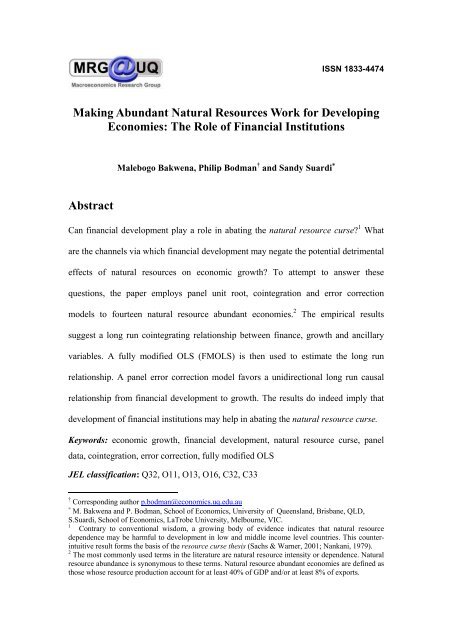

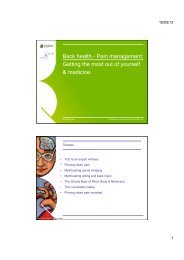
![Recycling [ PDF, 62KB ] - University of Queensland](https://img.yumpu.com/51805185/1/184x260/recycling-pdf-62kb-university-of-queensland.jpg?quality=85)
